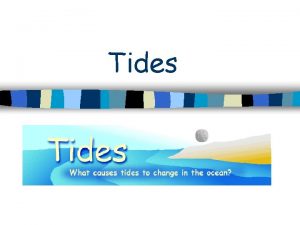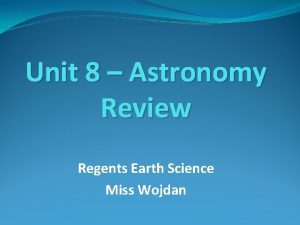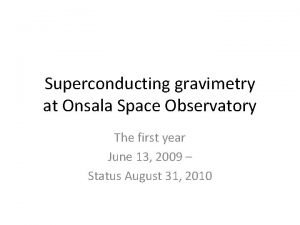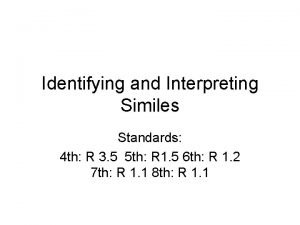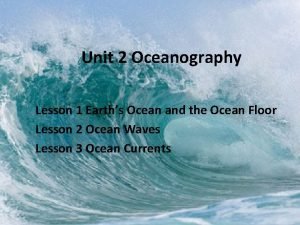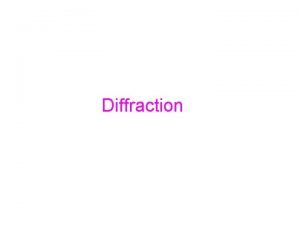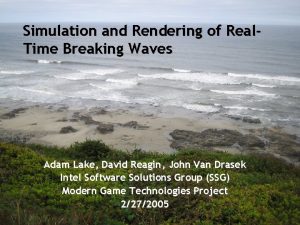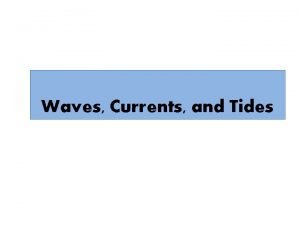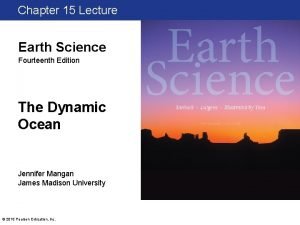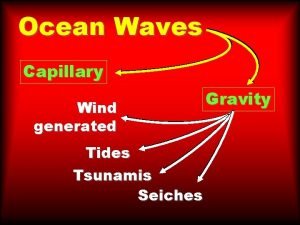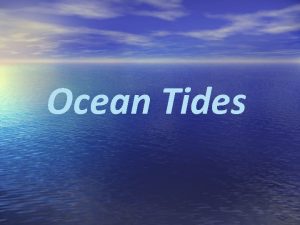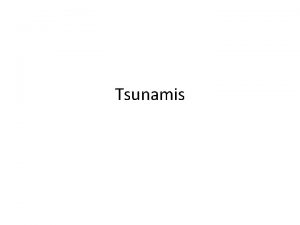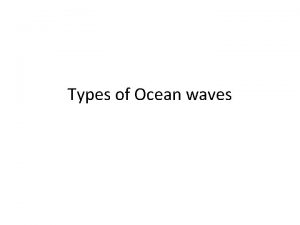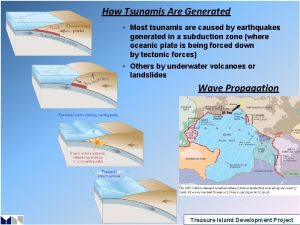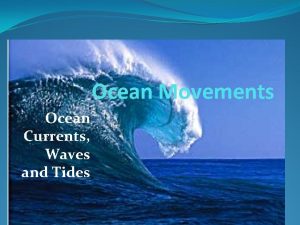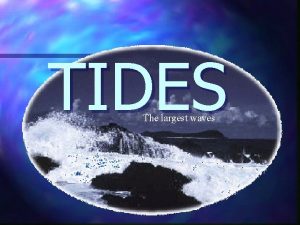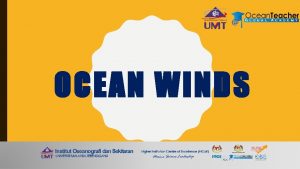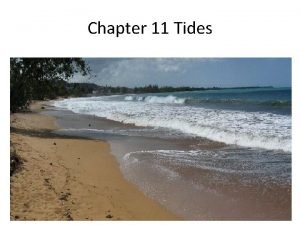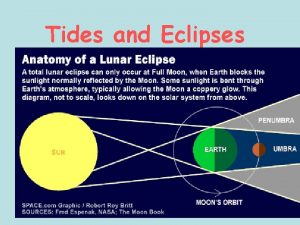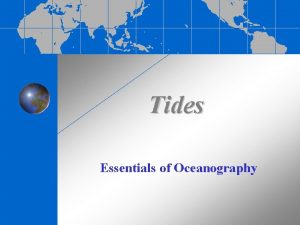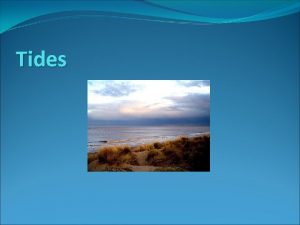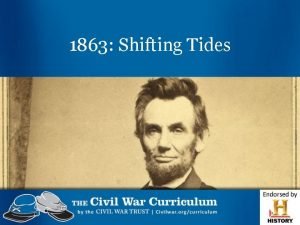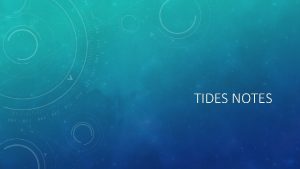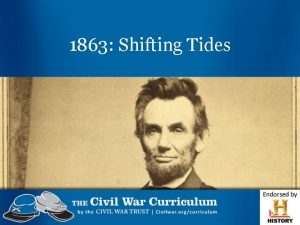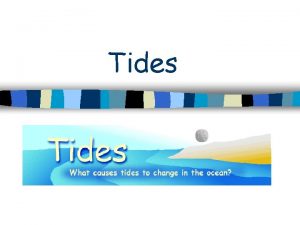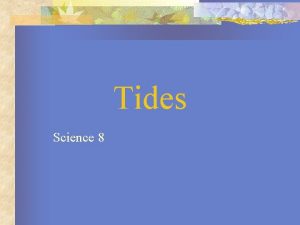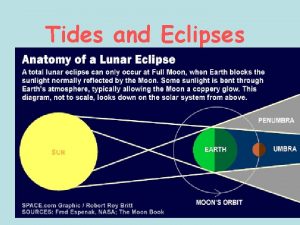Ocean Waves Capillary Wind generated Tides Tsunamis Seiches





























- Slides: 29

Ocean Waves Capillary Wind generated Tides Tsunamis Seiches Gravity

Capillary waves are driven by the surface tension produced by electrically polarized water molecule

San Pedro Lighthouse

Waves n are alternate rises and falls, describable as simple/complex sinusoidals

Crest 1 Amplitude 0. 75 0. 25 Height 0 -0. 25 0 -0. 5 45 90 135 180 225 270 315 360 Wave period or Wavelength -0. 75 -1 Amplitude Trough

As a wave travels through the waver, the particles travel in clockwise circles. The radius of the circles decreases as the depth into the water increases. The following animation shows a water wave traveling from left to right in a region where the depth of the water is greater than the wavelength of the waves. http: //www. kettering. edu/~drussell/Demos/wavemotion. html


Waves n n are alternate rises and falls, describable as simple/complex sinusoidals only add-up, always i. e. , wave interference can be constructive and/or destructive

1 A 0. 5 B 0 0 -0. 5 -1 90 C 180 270 360

1 0. 75 A B 0. 5 0. 25 C = A+B 0 -0. 25 0 -0. 5 -0. 75 -1 45 90 135 180 225 270 315 360

1 0. 5 B A 0 0 90 -0. 5 -1 C 180 270 360

4 3 2 Waves interference is always additive 1 0 -2 -3 -4 4 100 200 300 400 500 600 700 This is the algebraic sum of these 3 2 1 0 -2 -3 -4 100 200 300 400 500 600 700

Wave interference can be constructive or destructive 1 0 0 -1 360

1 0 -1 Constructive interference Destructive interference Constructive interference

Waves and wave activity First Harmonic Standing Wave Pattern • Standing waves As waves can be thought of as single or complex sinusoids, we can look at waves as comprising one or more harmonics. Second Harmonic Standing Wave Pattern Third Harmonic Standing Wave Pattern http: //www. glenbrook. k 12. il. us/gbssci/phys/mmedia/wave

Waves and wave activity • Traveling waves Waves travel in groups, and the group velocity is onehalf the velocity of individual waves. http: //www. glenbrook. k 12. il. us/gbssci/phys/mmedia/waves/swf. html

Waves n n n are alternate rises and falls, describable as simple/complex sinusoidals only add-up, always i. e. , wave interference can be constructive and/or destructive carry energy, not matter light is an exception, it travels in waves and as particles

103 Capillary waves Wave speed or velocity (cm/s) 104 Gravity waves in deepwater, 102 V 1. 25 L 10 1 10 -1 1 102 103 104 Wavelength (cm) 105 106 107

Output from a shallow water equation model of water in a bathtub. The water experiences five splashes which generate surface gravity waves that propagate away from the splash locations and reflect off of the bathtub walls. http: //en. wikipedia. org/wiki/Ocean_surface_wave

Waves carry energy, not matter The orbital motion of representative water molecules: orbital size decreases with depth, with negligible water motion at depth ½ wavelength Elliptical path: waves of translation Circular path: waves of oscillation

Waves break on reaching the shore. Why?

Waves break as the succeeding waves catch up with preceding waves

Spilling breakers form when the bottom slopes gradually

Plungingor orsurging breakersformwhenthe bottomslopeis issteep

Three factors affect wind wave development: (a) Wind speed, (b) Wind duration, and (c) Fetch

How wind affects the wave height

Conditions conducive of a fully developed sea Wind Conditions Wind speed 19 km/hr (10 knots) 37 km/hr (20 knots) 56 km/hr (30 knots) 74 km/hr (40 knots) 92 km/hr (50 knots) Wave Size Fetch Wind duration Average height Length period 19 km 2 hr 0. 27 m 8. 5 m 3. 0 sec 139 km 10 hr 1. 5 m 33. 8 m 5. 7 sec 518 km 23 hr 4. 1 m 76. 5 m 8. 6 sec 1313 km 42 hr 8. 5 m 136 m 11. 4 sec 2627 km 69 hr 14. 8 m 212 m 14. 3 sec

Wave energy versus wavelength for fully developed sea: Stronger winds generate waves that are both longer and more energetic, on average Relative wave energy 75 km/hr 55 km/hr 37 km/hr 20 50 100 200 Wavelength (m) 500 1000

http: //www. oceanweather. com/data/global. html
 Citlalli dominguez
Citlalli dominguez Periodic rise and fall of sea level
Periodic rise and fall of sea level Compare and contrast spring tides and neap tides.
Compare and contrast spring tides and neap tides. Properties of waves
Properties of waves Ocean tides observed at coastal locations
Ocean tides observed at coastal locations Ocean tides
Ocean tides Waves and tides
Waves and tides Nekton include all animals that
Nekton include all animals that Ocean ocean convergent boundary
Ocean ocean convergent boundary Ocean to ocean convergent boundary
Ocean to ocean convergent boundary Convergent plate boundaries
Convergent plate boundaries Ocean to ocean convergent boundary
Ocean to ocean convergent boundary Ocean ocean convergent boundary
Ocean ocean convergent boundary Blue og red ocean
Blue og red ocean Convergent ocean to ocean
Convergent ocean to ocean Wind von backbord weicht wind von steuerbord
Wind von backbord weicht wind von steuerbord Similes about the beach
Similes about the beach Current pattern
Current pattern The phenomenon of diffraction can be understood using *
The phenomenon of diffraction can be understood using * Breaking waves
Breaking waves Study jams waves
Study jams waves Ocean waves
Ocean waves Seismic waves are mechanical waves
Seismic waves are mechanical waves Sound waves are electromagnetic waves true or false
Sound waves are electromagnetic waves true or false Is echolocation transverse or longitudinal
Is echolocation transverse or longitudinal Mechanical waves vs electromagnetic waves
Mechanical waves vs electromagnetic waves Compare and contrast p waves and s waves using venn diagram
Compare and contrast p waves and s waves using venn diagram Example of mechanical wave
Example of mechanical wave Mechanical waves and electromagnetic waves similarities
Mechanical waves and electromagnetic waves similarities Long waves and short waves
Long waves and short waves

